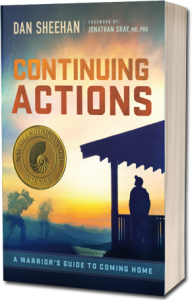Continuing Actions Chapter 8
KUM BAY YAH, ANYONE?
“In the second stage of recovery, the survivor tells the story of the trauma. She tells it completely, in depth and in detail. This work of reconstruction actually transforms the traumatic memory, so that it can be integrated into the survivor’s life story.” —Judith Lewis Herman, Trauma and Recovery, p.175
TO UNDERSTAND THE EMOTIONAL effects of your experiences, you must tell your own true narrative. Don’t get freaked out—this isn’t some New-Age, self-help catch phrase, and it isn’t going to require joining a drum circle.
Your own true narrative is simply your story—what you saw, did, didn’t do, heard, smelled, tasted—and how it made you feel. That’s it. How does this help you to move forward on your journey? By bringing the events, actions, emotions, and reactions of combat into the light. Only after these insurgent forces have been brought out of the darkness can they be consciously assimilated into your life.
There doesn’t have to be a moral to this narrative or some underlying theme that ties it all together. You may find that, you may not. There is only one thing this narrative must contain and that’s the truth. This is not the time to consider what you think people want to hear or how you want them to see you. Incorporating those external considerations will reduce what could be a crucial step forward in your journey to just a throw- away story—something to tell a stranger at a bar. A story like that hinders progress and encourages stagnation, the exact opposite of what your own true narrative will do for you.
It is important to remember the goal of this first step. You are not writing a book or a journal for other people to read. This is just for you. You may choose to share it later, but this first round of excavation is meant to simply pull all the emotions and reactions out of the darkness to give you a chance to make sense of them yourself. Once you’ve accomplished that, you can decide whether or not to share what you discovered and the means through which to share it.
The value in telling your own true narrative is in the journey it takes to learn it. That’s what we’re going to talk about here.
GATHERING THE INTEL
I have a hard enough time remembering what I did last week, let alone years ago. Our memories fade over time, and often our combat experiences seem to morph together into one long period. Memories that, at the time, felt scorched into our souls somehow become hard to recollect. Details slip away and events become jumbled up together like so many writhing snakes, seemingly impossible to separate. As a result, we usually associate our combat experiences with broad-brush emotions that are incapable of carrying the nuances we’d actually felt.
Combat isn’t a uniform experience. There are good times, shitty times, and times that fall somewhere in-between. If we are to understand how various events impacted us, we have to make them—and our reactions to them—stand alone from all the rest. We need to tie our reactions to specific events as opposed to the entirety of a deployment or career. But because of the way our minds work, extracting the details of past events, especially traumatic ones, can be very difficult.
“Traumatic memory is not narrative. Rather, it is experience that reoccurs, either as full sensory replay of traumatic events in dreams or flashbacks, with all things seen, heard, smelled, and felt intact, or as disconnected fragments. . . . In other instances, knowledge of the facts may be separately preserved without any emotion, meaning, or sensory content.” (Shay, Achilles in Vietnam, p.172)
Even locating the memories and emotions of our experiences in combat can be a challenge. But, we can circumvent our mind’s attempts to keep us from accessing that information if we develop, and stick to, a plan.
SELF-AID: DE-COMPARTMENTALIZATION11:
STEP ONE
The first step in the process of constructing your narrative is to create a list of events that occurred during your deployment(s). These will likely be the “big” ones—the date you arrived in country, your R&R, major operations, noteworthy firefights, holidays, the day a buddy was killed—and will form the framework of your deployment(s) so you can begin filling in the gaps. Get a calendar, or make one, and put any remembered occurrences on their actual dates.
A whole lot of stuff happened between those dates though. Now you have to figure out what those more minor events were. Use the “big” events as a trail of breadcrumbs to follow backward into your memories. Jot down smaller events in relation to the bigger ones—before or after—and don’t necessarily worry about the actual dates.
Of course, if you kept a diary, then use it. If you kept mission notes or a debrief logbook to record information for intelligence reports, then use them. Anything that you wrote during that time frame is valuable here. I used my own journal, my kneeboard cards from actual missions, my flight-hour logbook, and hours of gun-camera footage from my helicopter to rebuild my experiences while writing After Action. I plotted grid coordinates of various incidents and engagements on GoogleEarth and recreated as much of the aerial control point system as I could. You’re trying to reconstruct something that happened years ago, and each bit of information is a puzzle piece. Pulling together as many puzzle pieces as possible gives you the best chance of actually creating a cohesive picture.
This is an opportunity to call in a little buddy-aid as well. Reach out to former comrades and use them to help rebuild your memories. Maybe they remember things you don’t, or maybe they kept a journal and will share it with you. I was able to borrow my co-pilot’s journal and found that he had recorded things I’d missed. Even more important than just gathering information, though, were the conversations it started. I couldn’t just ask, “Hey dude—could I borrow your journal from Iraq?” I had to explain what I was doing, why I was doing it, and what I hoped to get from accessing his memories. This request for support broke an unspoken agreement to never admit any confusion or difficulty over what we had done. It was as if we believed our emotions could be ignored out of existence by not mentioning them. But asking to borrow his journal finally broke that foolishly naive pact. We’d fought in multiple engagements together, buried good friends, and have been best friends for years. But I had to take the first step and admit that something was bothering me before we began to have honest conversations about how those experiences actually impacted us.
DE-COMPARTMENTALIZATION:
STEP TWO
Once your personal deployment calendar contains some solid information, it is time to move to the next step. Get a 3-ring binder with loose-leaf paper in it. Dedicate a sheet of paper to every date you’ve marked on your calendar and write what happened on that date. Begin with the bare facts—the who, what, when, where, and why of the event—just like you’re going to turn it in for an after-action report. If anything else comes to mind then record that as well. Don’t force it though; move on to the next significant event on a different sheet of paper if you get stuck.
This first recording of events will likely jog your memory. Each event initially exists in isolation in your mind, but the effort of recording the details forces you to examine that event closely. In doing so, other events linked to these primary ones may pop up in your memory. Capture them and write their details on their own sheet of paper. The goal here is to impose a basic level of organization on the memories jumbled by compartmentalization so that you have a thorough, tangible record of your experiences in combat.
Now it’s time to go back through that binder and add another layer of information. This is the tough part—remembering and recording emotions created by those events. But don’t worry; nobody ever needs to see what you write here. This notebook is simply your tool to use, your place to dump the memories and emotions extricated from the compartments in your mind.
Go back through your binder a few times with an eye toward what these events made you feel. Underneath the bare facts of each event, write the reactions that come to mind. They can be from the day itself, or how you are feeling right then and there as you think about it. Either way, you are accessing the compartmentalized reactions created by the event and jotting them down on paper—they can’t be stuffed away again. That’s not to say that you’ll experience everything again in a rush. The walls of compartmentalization are solidly built and will not allow much to escape. But each little bit that does get out is a step in the right direction.
Flashes of compartmentalized emotions that do escape, if not recorded, usually get recaptured and stuffed away again by our conscious mind, thus ensuring they will escape again in the future. But writing them down circumvents this re-compartmentalization reaction and gives the emotions a place to live outside your head.
You may have to go through this process multiple times. If you can’t remember how you felt at a certain event, try to remember what your body felt like. Did your teeth hurt from gritting them for so long, or your hands ache from crushing your weapon? Was your heart racing even though you weren’t doing anything physical? Our bodies react to emotions even when we successfully compartmentalize them. Recalling those physical sensations can provide important clues to remembering the emotions that caused them.
It is quite possible that, during the process of remembering and recording the events and emotions of the past, you’ll find yourself experiencing those emotions in “real time” again. Be aware that this can happen and prepare for those emotions to interrupt and intrude in your daily interactions. Ramp up your self-aid activities, use buddy-aid by letting friends and family know what you’re doing so they can help, and always keep the door open to seeking corpsman-aid. Uncovering a memory that requires immediate corpsman-aid is not a bad thing. Quite the opposite. It means that you can go to your first meeting with your counselor with a concrete starting point. This can literally save you hours of sifting through memories and events to uncover the root cause of your unease.
Back to the second step of de-compartmentalization.
Another good tool to use in this stage is the correspondence with friends and family—more buddy-aid. Letters and emails we sent back from the war zone often contain hints of our emotional state at that time. But we may not have written our true emotions down—we usually wrote what we wanted them to be, not what they were. I remember sending my then-girlfriend, now wife, a letter after one mission on the ground in Baghdad. The breaching charge we placed on the front door of the target house blew just as a woman inside was reaching for the handle. She took the brunt of the blast, and the door broke her nose when it flew off its hinges.
After we’d secured the house and captured our target, she refused to allow our corpsman to give her medical assistance. Our “Terp,” an Iraqi American from Detroit, dismissed her with a casual wave when she launched into an angry tirade from behind a mask of streaming blood. In the letter to my girlfriend, I angrily berated this woman for being such an idiot. We didn’t want to hurt her; she should have kicked her dickhead husband to the curb for planting IEDs and then we wouldn’t have had to blow her door in and wreck her house. It was her own damn fault, I wrote. Truth was, I felt like shit that this woman had been hurt by our actions—even more so because I did nothing to help. I just focused on my job and got to the roof where I could control the aircraft protecting our small force. Reading the misplaced anger and total confidence in my perceptions of right and wrong in that letter now makes me cringe.
The emotions we wrote in those letters will often ring hollow if they’re not really what we’d been feeling. This hollowness is apparent only to us because our unconscious mind shouts “Bullshit!” when we read our words from years ago. This is a clue telling us that we should pay attention. This hollowness is our unconscious telling us we’re on the right track, that we need to dig deeper here to uncover buried emotions. These are the ones leeching poisons into our emotional groundwater. They’re what we’re looking for.
We might write about feeling angry at the Iraqis for using kids as shields or bombers, but what we’re really angry about is the fact that they put us in a position where we had to kill kids— or even contemplate it. Aggressive professions of our inherent “goodness” are often used to cover up the painful realization that we are neither as good nor as altruistic as we claim to be. This is especially true when we can look back and see how much pain we caused while simultaneously knowing, without a shadow of a doubt, that we’d done the right thing at the time.
The truth is, few people are more likely to experience the full disillusionment of smashed ideals than a warrior in combat. Ideals created and nurtured in peacetime rarely survive the ugliness of human combat. And as these ideals often define what’s right and wrong, when they are crushed by the harsh realities of war, the warrior’s concepts of right and wrong get crushed as well.
There’s no time limit for gathering this information. It will take as long as it needs to take. But over time, your binder will contain the facts about your experiences and the general emotions they created. By giving them a place to live outside your head, you’ll defuse their incessant escape attempts—the emotions will calm down and you’ll be ready to move to the next step. You’re closing the chasm by this point, but you’re not done yet. You still have to gain perspective on the entirety of your experiences—not just individual events. To do that will require, you guessed it, more writing.
DE-COMPARTMENTALIZATION: STEP THREE
“The recitation of facts without the accompanying emotions is a sterile exercise, without therapeutic effect. As Breuer and Freud noted a century ago, “recollection without affect almost invariably pro- duces no result.” —Judith Lewis Herman, Trauma and Recovery, p.177
Get something fresh to write on. Could be a journal, a notebook, or a computer—whatever you’re most comfortable with. This is the stage where you are going to put all your previous work together and connect the emotions and events into a single narrative or story. Start at the beginning event, the first page in your 3-ring binder, and write out what you did, where you did it, who you did it with, what it felt like, and how you feel about it now. Include all the emotions you can remember, and spend time on the details. It can literally take days to uncover the emotions and reactions generated by a single event. Go from significant event to significant event, filling in the gaps with any additional information that comes to mind. It may read like an overly personal after-action report, it may read like stream of consciousness, or it may read like a novel. It doesn’t matter what it reads like. All that matters is that you spend the time and energy required to get it right.
If writing is not something that comes easily to you, don’t worry—buddy-aid is available for this, too. You’ve done the hard work to collect all your raw material; now you just need some help organizing it.
At this point in my own journey, I had the good luck to stumble upon David Hazard, founder and director of Ascent, an international coaching program for authors, and the man who would become my writing coach. I’d already written the first draft of After Action—over 420 pages of who-what-when-where details—when we started working together. While it was essential for me to write that first draft, it was nothing anybody else would ever want to read. It was just for me, an opportunity to put my experiences on paper and organize them outside my head. Actually, the writing was crap, devoid of emotions and personality. I would have to delve much deeper into how my experiences had affected me if it was to have any hope of becoming a book, even though at that time, I wasn’t certain I wanted it to.
I was not an easy client for David. I was so wary about admitting I even had emotions that any attempt by him to get me to describe how something had made me feel made me clam up. I could tell him that I drove a missile into a truck and watched bodies fly, but when he asked what I was really thinking during that experience or how it made me feel . . . my mind went blank. I was nervous that if I shared the smallest emotional response, I’d immediately end up banging a drum around a fire singing “Kum-Bay-Yah” with a bunch of teary-eyed dudes greased up with baby-oil. That just wasn’t going to happen.
Because I knew I had to dig deeper, though, I kept going. Over time I developed trust in David—I knew I could share painful and confusing emotions with him and he’d listen without judgement. More than that, I knew he wouldn’t laugh or think less of me because I admitted being human. Eventually, David’s questions helped me pull information out of hidden compartments I didn’t know existed. He became my sounding board and was often the first person to hear how my experiences had made me feel. He helped me to sort through what I wanted to open up about and what should remain private, kept just between me and my very closest loved ones and confidantes. In other words, I remained in control and could still set my own limits on what I shared and what I didn’t. Just because I became aware of something didn’t mean I had to share it. This opening up and sorting as we went was a crucial “first step” in communicating my experiences. It gave me the confidence to share with family, friends, and, eventually, anybody who picks up the book. I couldn’t have defined it at the time, but David’s help with my writing was invaluable buddy-aid support for my own self-aid plan.
There aren’t enough “David Hazards” to go around, though. This is where veterans’ writing groups come into play. You can contact colleges, community centers, or Veterans Administration facilities and ask if they know of any veterans’ writing workshops or seminars near you. Or take a look online—a quick Google search will provide links to Veterans Writing Project, Veterans Writing Group, and veterans’ writing workshops all around the country. Find one that is close to you and make the effort to get involved. Go to a meeting and find out if they’re a good fit for you. Share with them as little or as much as you want, but, as is true with anything else, remember this:
The more you invest of yourself, the more you’ll get out of it.
Mentoring, support, and a shared desire to use writing as a tool for personal growth and healing are hallmarks of these groups. If the thought of sitting behind your computer or notebook by yourself is terrifying—or mind numbingly boring— you’re not alone. But don’t let that derail your self-aid plan. Chances are good that the veterans in the writing group have traveled the same road you’re on and they can help. More than that, they want to help. That’s likely why they’re there.
Whether you write in solitude or with guidance from a confidant, you are the only person who will know if you “got it right.” If what you wrote accurately reflects what you felt—and feel—about that particular event, then you’ve done it right. A good way to test this is to let your narrative sit unread for several days or even a few weeks. Then reread it with fresh eyes. If what you’ve written doesn’t trigger any “bullshit” flags, then you’ve succeeded. You’ve uncovered your compartmentalized reactions and have begun to process them.
A final step remains though—one that will carry you many steps down the road to fully returning from war.
You have to communicate your experiences to another person.



